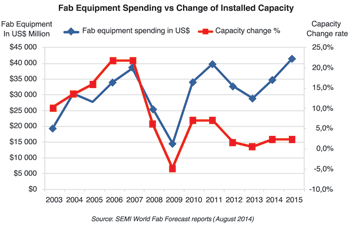Fab equipment spending shows strong growth
19 November 2014
News
Semiconductor front end fab (fabrication) equipment spending (including new, used and in-house) is projected to increase up to another 20% in 2015 to $42 billion, according to research from SEMI.
In 2015, equipment spending could mark a historical record high, surpassing the previous peak years of 2007 ($39 billion) and 2011 ($40 billion).
In 2014, the report predicts growth of approximately 21% for front end fab equipment spending, for total spending of $34,9 billion. Seven companies are expected to spend $2 billion or more in 2014, representing almost 80% of all fab equipment spending for front end facilities; a similar pattern is expected in 2015. About 90% of all equipment spending is for 300 mm fabs.
According to SEMI’s World Fab Forecast, in 2014, the five regions with the highest forecast spending on equipment are Taiwan ($9,7 billion), Americas ($7,8 billion), Korea ($6,8 billion), China ($4,6 billion) and Japan ($1,9 billion). In 2015, the same regions will lead: Taiwan ($12,0 billion), Korea ($8,0 billion), Americas ($7,9 billion), China ($5,0 billion) and Japan ($4,2 billion). Spending in Europe is expected to nearly double (from 2014 to 2015) to $3,8 billion.
As Figure 1 illustrates, before the last economic downturn, most equipment spending was for new additional capacity. SEMI reports that in 2010 and 2011, fab equipment spending growth rates increased dramatically, but installed capacity grew by only 7% in both years. In 2012 and 2013, installed capacity grew 2% percent or less. Some industry segments, such as foundries, see continuous capacity expansion, while other segments show much lower growth – pulling down the total global growth rate for installed capacity to below the 3% mark.
Figure 1. Fab equipment spending since 2003 and the change of installed capacity
(excluding discretes and LEDs).
In addition to foundries, the World Fab Forecast report captures capacities across all industry segments as well as system LSI, analog, power, MEMS, LED, memory and logic/MPUs.
DRAM is now slowly coming out of a declining trend with -3% growth in 2014 and reaching close to zero by end of 2015. Over the past three to four years, some major players have switched fabs from DRAM to system LSI or Flash, while others have discontinued DRAM production completely, contributing to declining DRAM capacity.
The SEMI forecast also provides detailed data about fab construction projects, with spending expected to total $6,7 billion in 2014 and over $5,0 billion in 2015. In 2014, the leading regions for construction spending are Taiwan, Americas and Korea. In 2015, the highest spending is expected in Europe/Mideast, followed by Taiwan and Japan.
For more information visit www.semi.org
Further reading:
Electronic News Digest
News
A brief synopsis of current global news relating to the electronic engineering fields with regards to company finances, general company news, and engineering technologies.
Read more...
4000 A containerised DB for power project
News
Power Process Systems has successfully completed the design, fabrication, and commissioning of a 4000 A containerised distribution board for a wind/PV solar hybrid renewable energy project.
Read more...
Datacentrix Industrial Indaba 2025
News
Datacentrix recently hosted its inaugural Industrial Indaba 2025, where industry leaders explored how digitalisation, resilience, security and compliance are shaping the future of sustainable industrial operations in Africa.
Read more...
RS brings solar light to 150 000 people
RS South Africa
News
The company’s three-year partnership with SolarAid aims to raise £1 million through corporate donations, matched funding, product contributions, and fundraising to accelerate access to safe, sustainable energy.
Read more...
Microchip and AVIVA Links collaboration
Altron Arrow
News
Microchip and AVIVA Links have achieved groundbreaking ASA-ML interoperability, accelerating the shift to open standards for automotive connectivity.
Read more...
World’s leading supplier of grid automation products
News
Hitachi Energy was recognised as the global market share leader in grid automation for electric power transmission and distribution utilities by ARC Advisory Group.
Read more...
Vivashan Muthan appointed as head of export sales and operations at RS South Africa
RS South Africa
News
With a career spanning engineering, business development, and sales leadership across sub-Saharan Africa, Vivashan Muthan brings a wealth of expertise to his new role as head of export sales and operations.
Read more...
Google equips university students across Africa with free access to advanced AI tools
News
A 12-month Google AI Pro plan has been launched for students in Ghana, Kenya, Nigeria, Rwanda, South Africa, and Zimbabwe to build foundational AI skills.
Read more...
Africa’s space economy projected to be worth $22,6 billion in 2026
News
South Africa is gearing up to be at the forefront of the growth in the space industry, creating thousands of jobs, driving innovation, and boosting the national economy.
Read more...
Distribution partnership with MacDermid Alpha
Testerion
News
MacDermid Alpha Electronics Solutions India Private Limited has announced that as of 01 September 2025 Testerion will be the sole importer and distributor of their products to the South African market.
Read more...


